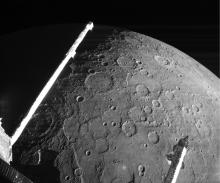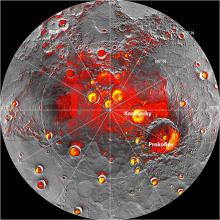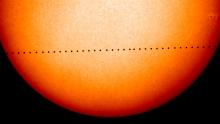Listen to today's episode of StarDate on the web the same day it airs in high-quality streaming audio without any extra ads or announcements. Choose a $8 one-month pass, or listen every day for a year for just $30.
You are here
Morning Mercury
A planet that’s as solid as a bowling ball is peeking into view in the early dawn sky the next few days. It’s low in the east-northeast as twilight begins to paint the sky. It looks like a fairly bright star, but it’s so low that you need a clear horizon to spot it.
Mercury is the closest planet to the Sun. It’s also the Sun’s littlest planet. It’s about half again the diameter of the Moon. And like the Moon, its surface is pockmarked by craters — the scars of countless collisions with space rocks over the last four and a half billion years.
On the inside, though, Mercury is built a lot like Earth. And a recent study revealed just how much.
Scientists carefully studied readings made by Messenger, a craft that orbited Mercury for four years. It monitored Mercury’s magnetic field. And scientists tracked Messenger’s orbit around Mercury, which revealed the planet’s gravitational field.
When combined, those observations allowed scientists to map the planet’s interior. They found that Mercury has a solid inner core made of iron, surrounded by an outer core of molten metal. The inner core spans more than a third of the planet’s total diameter. By comparison, Earth’s inner core accounts for only about one-fifth of our planet’s diameter.
That massive core means that Mercury is the planetary equivalent of a bowling ball — a heavy, dense little world spinning in its lane around the Sun.
Tomorrow: a giant planet that may be losing its “eye.”





